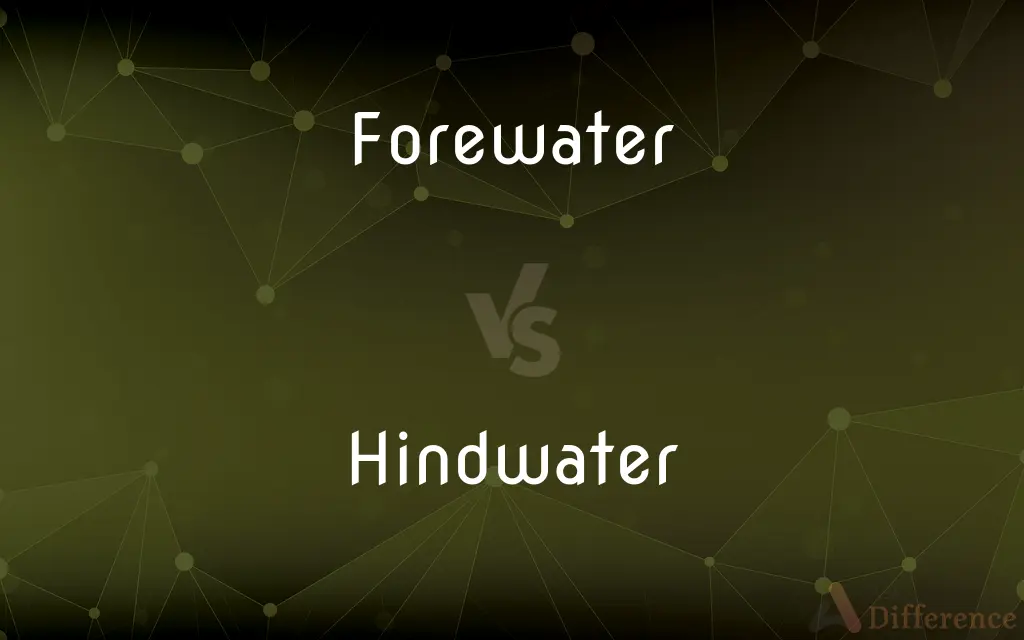Forewater vs. Hindwater — What's the Difference?
By Maham Liaqat & Urooj Arif — Updated on March 7, 2024
Forewater refers to the water ahead of a moving ship, emphasizing its role in navigation and potential obstacles, whereas hindwater relates to the water behind the ship, reflecting wake and past navigation.

Difference Between Forewater and Hindwater
Table of Contents
ADVERTISEMENT
Key Differences
Forewater is crucial for a ship's navigation, focusing on the water area that lies directly in front of a moving vessel. It's essential for identifying upcoming obstacles and determining the ship's course. On the other hand, hindwater pertains to the water area immediately behind a moving ship, which is significant for analyzing the vessel's wake and the effects of its passage through the water.
Navigational strategies heavily rely on understanding and interpreting forewater conditions, such as currents, tides, and potential hazards, to ensure safe and efficient passage. Whereas, hindwater analysis can provide insights into the ship's performance, including its speed and stability, based on the characteristics of its wake.
Forewater conditions can also influence a ship's speed and fuel efficiency, as encountering rough or adverse conditions may require more power to maintain speed. In contrast, smooth hindwater, indicated by a well-defined wake, can suggest optimal performance and efficient navigation.
The study of forewater is pivotal in predicting the ship’s interaction with new water bodies, including the anticipation of changes in water density, temperature, and movement. Conversely, hindwater examination helps in understanding the environmental impact of the ship's journey, such as turbulence caused to marine life and erosion of shorelines.
Technological advancements in navigation and ship design focus on optimizing interaction with forewater for improved hydrodynamics and fuel efficiency. Meanwhile, innovations in understanding hindwater, like wake studies, contribute to enhancing ship design and minimizing environmental impact.
ADVERTISEMENT
Comparison Chart
Definition
Water ahead of a moving ship
Water behind a moving ship
Significance
Navigation, obstacle avoidance
Wake analysis, environmental impact
Influence on Ship
Determines course and potential hazards
Reflects performance and stability
Technological Focus
Optimizing hydrodynamics and efficiency
Minimizing environmental impact, wake studies
Environmental Impact
Anticipating interactions with new waters
Understanding turbulence and shoreline erosion
Compare with Definitions
Forewater
It involves navigating and identifying potential obstacles.
Advanced radars help in mapping the forewater more effectively.
Hindwater
Hindwater effects include turbulence and potential environmental impact.
The research focused on hindwater effects on marine ecosystems.
Forewater
Forewater analysis is critical for route planning.
The route was altered based on the forewater current analysis.
Hindwater
Hindwater describes the water area immediately behind a moving ship.
The ship left a calm hindwater trail.
Forewater
Forewater refers to the area of water directly in front of a moving ship.
The captain scrutinized the forewater for icebergs.
Hindwater
Innovations aim to reduce hindwater environmental impact.
Eco-friendly designs are focused on minimizing disruptive hindwater.
Forewater
Its conditions affect ship's speed and efficiency.
Rough forewater demanded more engine power.
Hindwater
It is analyzed for wake patterns and ship's stability.
The engineers studied the hindwater to evaluate the new propeller design.
Forewater
Technology aims to optimize ship's interaction with forewater.
Hull designs are tested for their efficiency in cutting through forewater.
Hindwater
Its characteristics can indicate the ship's performance.
A smooth hindwater wake signifies optimal speed and fuel efficiency.
Forewater
The amniotic fluid that comes out before the baby's head during childbirth.
Hindwater
The amniotic fluid that comes out after the baby's head during childbirth.
Common Curiosities
What can hindwater tell us about a ship's performance?
Hindwater can reveal information about the ship's speed, stability, and efficiency based on the characteristics of its wake.
What does hindwater mean?
Hindwater refers to the water directly behind a moving ship, important for analyzing the ship's wake and environmental impact.
Can forewater conditions affect a ship's fuel efficiency?
Yes, rough or adverse forewater conditions can require more power to maintain speed, affecting fuel efficiency.
Why is the study of forewater important for ships?
Studying forewater is vital for route planning, obstacle avoidance, and ensuring the ship's safe and efficient passage through waters.
What technologies are used to study forewater?
Technologies include radar, sonar, and advanced navigation systems to analyze and predict conditions in the forewater.
What role does hindwater play in environmental impact?
Hindwater studies help in understanding the ship's impact on marine ecosystems, including turbulence and shoreline erosion.
What is forewater?
Forewater is the water located directly in front of a moving ship, critical for navigation and identifying obstacles.
How do forewater and hindwater influence ship navigation?
Forewater affects navigation and obstacle avoidance, while hindwater analysis provides insights into the ship's performance and environmental effects.
How does hindwater reflect a ship's stability?
A well-defined, smooth wake in the hindwater can indicate that the ship is stable and performing efficiently.
Why is understanding both forewater and hindwater important for maritime operations?
Understanding both is essential for comprehensive navigation strategy, ensuring safety, efficiency, and minimal environmental impact.
How do technological advancements impact interaction with forewater?
Advances in technology aim to optimize a ship's hydrodynamics and fuel efficiency by improving navigation and design for better interaction with forewater.
How is hindwater used in ship design?
Ship designers use hindwater analysis, especially wake studies, to enhance design for stability, performance, and environmental friendliness.
What are the environmental concerns associated with hindwater?
Concerns include turbulence that affects marine life and erosion of shorelines due to the ship's wake.
Is forewater analysis relevant for all types of vessels?
Yes, from small boats to large ships, forewater analysis is crucial for safe navigation and efficient route planning.
How do innovations in hindwater study contribute to shipping?
Innovations aim at reducing the environmental impact and improving ship design for better performance and efficiency.
Share Your Discovery

Previous Comparison
Tavern vs. Restaurant
Next Comparison
Cosecant vs. ArcsineAuthor Spotlight
Written by
Maham LiaqatCo-written by
Urooj ArifUrooj is a skilled content writer at Ask Difference, known for her exceptional ability to simplify complex topics into engaging and informative content. With a passion for research and a flair for clear, concise writing, she consistently delivers articles that resonate with our diverse audience.
















































